Government Policy
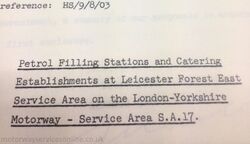
England's Department for Transport Circular 01/2022 ("Strategic road network and the delivery of sustainable development") is the strange title for the government policy which is used to regulate motorway service areas, rest areas, all-purpose trunk road service areas and truckstops in England, with the rest of the UK adopting it as best practice. Lay-bys and local facilities are no longer mentioned.
This page explains those regulations and how they have evolved, from a detailed and specific policy to a vague and hands-off one.
For a basic outline of the current minimum requirements, see:
The policy for Ireland, which is similar, is detailed further down.
Circular 01/2022
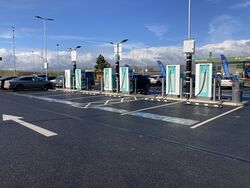
Following the UK's fuel delivery crisis in 2021, which was widely blamed on a shortage of delivery drivers, the government announced that the previous Circular 02/2013 would be reviewed again. The aim was to encourage the private sector to build more facilities for HGV drivers. Feedback was sought from stakeholders and the new policy was quietly published in December 2022.
Like its predecessor, the new policy focused on development generally, with service stations getting only a small mention at the end. It gave a lot of mentions to "decarbonisation" and "zero emission transport", and also removed all references to the Highways Agency, instead saying "the company". Despite this, it did result in many changes for service areas:
- While motorway service areas would remain no more than 28 miles apart (30 minutes for trunk A-roads), a new rule said that HGV parking must be available every 14 miles on motorways and 20 minutes on trunk A-roads. These figures include urban trunk A-roads, for the first time.
- National Highways should now object to service areas that don't qualify for motorway signage being built on motorway junctions (possible existing examples: Markham Vale, Frontier Park).
- There was talk of a new service area being "sympathetic to the character"; a rare interest from the government in design, although it's fairly meaningless in practise.
- Despite the clear preference for private sector development, the document acknowledged that there "may be a case" for highway authorities to provide facilities. National Highways should also "support the case" for new facilities in some instances.
- The "destination in its own right" rule was reinstated, a complete reversal of the previous policy.
- The preference for online over offline sites was changed from "should" to "must".
- Operators "must support the uptake of zero emission and hybrid vehicles".
- The requirements of an electric vehicle charging point were laid out, including a 24 hour helpline.
- CCTV and security lighting must be provided at new motorway service areas.
- Changing Places are now mandatory facilities.
- Payphones are no longer required (but free emergency calls must be allowed). Wifi and power points must be available instead.
- All minimum requirements may now be temporarily waived "for the purpose of managing traffic". This may follow recent issues such as COVID-19 and constant Brexit customs issues, but also acknowledges that emergencies happen.
- The wording of a minimum parking provision was changed from "all vehicles permitted to use the road served by the facility" to just "all vehicles permitted to use the facility". While it's a minor change, and possibly an error, it opens the possibility of new facilities choosing to ban certain types of vehicle.
The policy is available from Department for Transport.
In an unusual turn of events, in December 2023, the Department for Transport made up to £315,000 available for 76 roadside facilities in England to provide better facilities, under their 'HGV Parking and Driver Welfare Match Funding Grant Scheme'. This was allocated throughout 2024, both to major service areas and smaller truckstops.
EV hubs
When the policy was written, it still said all service areas must provide fuel. Amid the transition to electric vehicles, the government announced in 2025 that they would introduce "EV hub" as a class of facility. The new EV hubs have very similar requirements to A-road service areas; they must provide free parking, toilets and hot food during the daytime, but they may be up to 1 mile away from an English trunk A-road, and they don't need to provide fuel or toilets.
It's not entirely clear why a new class of facility was provided, instead of just saying that a "Services" must provide either fuel or charging facilities.
The new signs were backed up by an updated National Highways signage guide. Until September 2025, the drawings from 2013 had been cited. This updated guide was much more detailed, with higher quality drawings, detailed diagrams, and attention paid to a much broader range of circumstances - indeed its one of the most thorough documents they have published for a long time.
Circular 02/2013
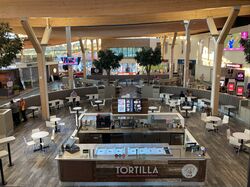
On 6 April 2010 a public consultation was launched regarding a review of previous policy. It is focused mainly on the economic benefits of new developments, and as well as replacing Circular 01/2008, it replaced another policy dealing with development on the strategic road network. It can be viewed from the Department for Transport.
The main changes for service areas were:
- Operators should ensure that drivers can pay parking charges retrospectively.
- The Highways Agency can step in to suggest a service area is desperately needed.
- The long-standing phrase "destination in its own right" was dropped, meaning service stations can add various facilities so long as they have the capacity for it.
- Hot food must now be available 24 hours a day on the motorway.
- Operators are encouraged to add electric car charging points.
- Operators are encouraged to secure HGV parking areas.
- The explicit ban on trading from bridges, and building bridges, was removed.
- Formulas for toilet capacity were removed.
- Picnic areas and play areas areas are no longer mandatory.
- Parent & child rooms and breastfeeding areas are no longer stated as mandatory.
- Minimum distances between service areas were removed.
- Introduction of caravan area signing.
- Live traffic information encouraged.
As part of a nationwide review of all traffic signs in 2011, some changes to the way service areas are signed were suggested, with brand logos being permitted on Diagram 2919.1 signs.
The Highways Agency became Highways England. While the new company inherited all the policies of the previous one, their stated aim was to pay more attention to the needs of all road users, which could have affected how they interpreted their policies. They then changed their name again in 2021, this time to National Highways. By this stage, what was left of their original roadside facilities department had now shrunk even further.
Circular 01/2008
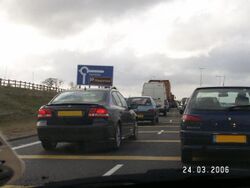
Circular 01/2008 can viewed be online. It was published in April 2008 after a Highways Agency consultation in 2007 and affected all planning applications created after 2 April. It was the first joint-policy for all roadside facilities, previously these had all been dealt with in separate documents and many aspects went unregulated.
The main changes were:
- The Highways Agency will oppose any 'change of use' plans at former service areas.
- Operators were reminded to provide a quality service, and an independent rating system was suggested.
- Rest areas were introduced to fill gaps of less than 40 miles, and new signs were created for these.
- The recommended distance between service areas was changed from 30 miles to 28 miles or 30 minutes, whichever is lesser.
- The minimum requirements were clarified. In particular, it was stated that substantial hot food must be offered between 6am and 10pm, but snacks may be sold at night.
- A preference was made for online service areas.
- Advertisements aimed at passing motorists were banned.
- Self-branded road signs were banned.
- Trading was banned from any new service area bridges.
- Park-and-ride systems, park-and-share points and coach interchanges were permitted, subject to an Impact Assessment.
- Tourist information points, game arcades and traffic information points were supported and regulated.
- TRSAs were no longer allowed in urban areas, or near rival facilities. It was clarified that they are for A-road approaches only.
- The rules were set out for signs for facilities in by-passed communities.
- A minimum design was set out for lay-bys where trading can take place and a licensing system introduced.
- A new sign for truckstops was created and the guidelines for its use set out.
- All the service area sign designs were put together on one page.
- The minimum number of toilets and parking spaces were set out.
- An absolute minimum distance of 12 miles was established.
- Hotels must have separate parking spaces again.
The document also included a series of formulas for deciding the number of parking spaces and toilets a service area needs. We have reproduced this in an interactive format.
Review of Strategic Road Network Service Areas
Circular 01/2008 established that the Highways Agency should have a greater role in the development of new service areas, so in February 2010 the Highways Agency published a review of the locations of service areas on motorways and suggested routes where new service areas should be developed, namely the A1 in North Yorkshire, M42 east of Birmingham, the western section of the M25 and the M5 in Gloucestershire.
It also looked at TRSA locations and suggested upgrading many sites.
MSA Policy Statement

Because Circular 01/94 (see below) was created as part of large changes to the motorway service area development process, in July 1998 the MSA Policy Statement attempted to address some issues which had been discovered after that was created. It is known in the trade as HA269, or the Whitty Statement. A copy of it is hosted on Motorway Services Online.
The notable points were that:
- Circular 01/94 had failed to see new companies enter the motorway service area market, but there had been a significant increase in applications from existing operators.
- Some councils were going to have to consider to needs of motorists over local residents on roads where new service areas are desperately needed.
- The M25 was listed as an exception to the rules, but it was stressed that the gap between service areas on it needed to filled by either one or two new service areas (this happened in 2012).
- Restrictions were put on the size of shopping and leisure areas within service areas.
- Operators were required to have their plans assessed before redesigning the internal layout in a motorway service area. It also suggested that 'normal' road signs were used instead of self-branded ones.
- Service areas were reminded to act in an environmentally and socially friendly manner, and their designs were supposed to sympathise with the environment.
One notable issue with the MSA Policy Statement was that it limited shopping areas to 5,000 square foot, but didn't state if this applied to the whole site at service areas with two sides to them. Granada tried to argue that it shouldn't, but the Highways Agency later advised them that it did.
Roads Circular 01/94
Roads Circular 01/94 was created in May 1994. It applied to service areas in England and Wales and a copy of it is hosted on Motorway Services Online.
In general it just reiterated what was in Circular 23/92, but a couple of the extra points were:
- A basic formula for the number of parking spaces required was created. The required number of spaces were expected to be available within 15 years of the service area opening.
- The Highways Agency (England) or Welsh Office (Wales) should be consulted whenever changes to facilities near a motorway are proposed.
- If any of these rules were broken then the signs for the service area could be removed and the accesses closed.
- Authorities were advised not to approve service areas built less than 15 miles from an existing one.
Circular 23/92
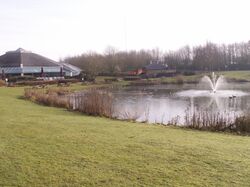
Roads Circular 23/92 was created in August 1992 to facilitate the deregulation of the industry. The main change was that the government would no longer own the land motorway service areas are built on, or influence who run them. In keeping with the Thatcher and Major ethos of selling the government's stake in various industries, the Department of Transport were selling their interest in service stations. This would fall under Major's "Citizen's Charter" initiative.
On announcing the changes, the Department of Transport said "there is a need for change", and pointed at a number of new motorways where they hadn't been able to lease service stations quick enough, not to mention the amount of government time that had spent on planning battles. They pointed at the way the Welsh Office had run the M4 as an example of the privatised system working. Quite simply, they argued that the Department of Transport was spending too much time trying to compulsory purchase land for service areas, and they believed developers would be able to acquire land faster.
The aim was to see more, smaller services providing a range of facilities. The government spoke about how service stations would be able choose to specialise in different areas, such as HGV facilities or quality food, and that - if there were privately owned motorways - different motorways could compete on the quality of their service stations.
A copy of Roads Circular 23/92 is hosted on Motorway Services Online.
The key points it established were:
- A general minimum distance of 15 miles between signed service areas was suggested. There was no maximum distance between service areas.
- Local planning authorities should take the needs of motorists into account (many councils included service areas in their transport policy).
- Free short term parking, toilets, fuel and a picnic area should be available 24 hours a day.
- Service areas were expected to control the use of rear accesses.
- New service areas should avoid being built in green belt land and should try to reduce their impact on the local environment.
- New service areas only had to be designed to handle 15 years of traffic, making them smaller than previous ones which were designed for the next 30 years.
- The service areas were expected to be fully-accessible to disabled people and the sale and consumption of alcohol was banned. This was actually the first policy to refer to the sale of alcohol - previously the licensing act had prevented motorway service areas from selling alcohol, the wording of it meant that when developers started planning motorway service areas they weren't covered by it, creating an unusual legal loophole.
- Further requirements, like the sale of food, would be decided on a case-by-case basis. This allowed for exceptions in difficult situations.
Service areas would need a Traffic Signs Agreement before access to the motorway would be provided, and this agreement would be used to regulate behaviour.
Circular Roads 4/88
Circular Roads 4/88 was the predecessor to 01/94. It was published in November 1988 and a copy of it is hosted on Motorway Services Online.
The policy wasn't about service areas as such, but "controlling development". This was because it assumed all motorway service areas were built on land owned by the government, and were prohibited from misbehaving by their contract with the government and by the government's role as landlord. The sale of alcohol, for example, isn't mentioned as this was covered by the licensing act.
The policy stated that only service areas and junctions can have direct access from the major road network, with a few exceptions on urban trunk roads.
The network of service areas was described as "key sites with substantial diversification" rather than a network of frequent, smaller service areas. A policy of not allowing service areas which force traffic to turn right across dual carriageways was also established.
As an aside, the document also talks about trunk roads which are "being built to near motorway standards", something that became really prevalent in the early 2000s.
1987 Statement
Circular Roads 4/88 was partly based on the statement by Paul Channon, Secretary of State for Transport, on 1 July 1987.
This announced that motorway service areas would now be built 30 miles apart, that competition would be encouraged between sites, and that a network of A-road service areas should be created through private enterprise.
Prior to this, the Motorway Service Area Management Group/Board (1969-1988) were responsible for ensuring motorway service areas acted responsibly. The Prior Report prompted a change in some of the historic legislation. The system of fees was totally overhauled, and moved towards operators purchasing a 50 year lease in exchange for a peppercorn rent, with solo fuel brands allowed and hotels permitted. The government stated in 1979 that they wanted to "disengage" from service station management.
Highway General Division
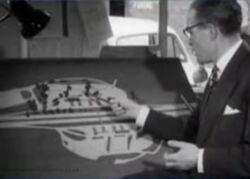
When the motorways were first built, service stations were defined by the Special Roads Act, later the Highways Act. The regulation was focused on the practical issues, and defined by government policy.
The basic principle of being able to acquire land for facilities was approved in September 1955. More detailed agreements and policies would soon specify:
- Service areas to be built at 12 mile intervals, with alternate sites developed initially.
- Facilities would not provided elsewhere on the motorway, and not everything provided at every site.
- Thy would be built and operated by private tenders under a 50 year lease with regular inspections (later reduced to 20 before being scrapped; larger firms wanted the security of 99 years). On legal advice, the government insisted each site have one operator, with no sub-leasing.
- Adjacent sites not allowed to be owned by the same operator (see: adjacency rule).
- Operators would pay annual rent plus percentage of turnover.
- Petrol supplies to be multi-brand (revised in the 1970s)
- No motels to be provided.
- Alcohol initially allowed when served with food, though this was overruled by the 1961 licensing bill.
- Minimum toilet and parking requirements would be stated in contracts.
- Minimal repair facilities to be available, but operators must be able to recover nearby broken vehicles, when called upon.
- Minimal advertising to be visible.
- The Ministry would make regular inspections.
- Trunk motorways less than 18 miles need not have service areas.
- Payphones to be provided (usually BT or Mercury).
- Opening hours were not regulated, but they all opted to be open 24 hours a day.
Guidance notes would be issued to every company who wanted to bid to develop a service area, covering subjects such as capacity and design. These notes became increasingly detailed, containing instructions such as "full use should be made of worthwhile views out of the site where these exist".
One interesting design point was that each side of a service area didn't need to be directly opposite the other, however if they were staggered, traffic needed pass its side before the other. Early motorways had no central barrier, so if they saw a petrol station on the other side, there were fears people might do a U-turn, rather than wait for the one on their side of the road.
In addition, service areas were contractually required to enter into an agreement with the local police force to pick up vehicles broken down near the service area and tow them to the car park, where basic repairs could be undertaken. This proved to be a source of frustration for many operators.
In 1967 fuel and tobacco duty were removed from the turnover calculations, on the advice of highway engineer Ron Bridle. The building of post offices, takeaway shops, and provision of unisex toilets, were later added to the minimum requirements. Rules were changed to allow for charged long-stay parking, more comprehensive repair facilities and more items in the shops, in 1971.
Additional advice on service area planning was provided in Planning Policy Guidance 13, as well as government statements such as ones in 1974 and 1987. These were particularly useful for A-road service areas, and said they should be positioned at junctions, at 12-25 mile intervals. Circular 25/58 (from 1958) said that rural roads should have petrol stations 12 miles apart; this was before the modern service area had even been thought of, but it paved the way for future regulations.
The Highways Act allowed compulsory purchase orders to be used to acquire land so that it can be used "in connection with the use" of the road. This was taken to mean service areas couldn't be used to provide facilities which motorists didn't need: in other words they can't be a "destination in their own right", a phrase which was repeated for many decades.
1986 Statement
See also: Private Initiative
A government statement in July 1986 introduced a new method of developing service areas. This was - officially at least - the first time there was an option of building a new motorway service area without having to bid against other developers for a specific site.
Some sites would now be developed by inviting operators to suggest a suitable location. Others would involve negotiating with a single developer. It opened the doors to major changes in 1992.
Scotland
SPP 17 and PAN 75
Both of these documents were published in August 2005 following a reorganisation of transport-related documents. The two documents dealt with a whole range of transport issues as well as service areas, and can be viewed online - SPP 17, PAN 75. Most of it was the same as NPPG9, with the main exceptions being:
- Service areas were expected to control the use of rear accesses.
- Service area signs can be removed if a site breaks the minimum requirements.
- It was suggested that service areas support the local community.
- It was suggested that service areas had an element of competition within each site.
NPPG9
NPPG9 (full title The Provision of Roadside Facilities on Motorways and Other Trunk Roads in Scotland) was published in October 1998 and can be viewed online. The document was very similar to England's Roads Circular 01/94, the main differences being:
- Service areas should provide adequate facilities on both sides of the road.
- The A9 was listed as an exception to the usual rules whereby bypassed communities provided all the facilities.
- A restriction was put on the size of retail areas.
- Service areas should provide value for money(!)
Wales
Wales has always relied on developer's proposals for motorway service areas. Their system was the inspiration for the English system to change in 1992.
Since then, Wales has always adopted England's policies.
Ireland
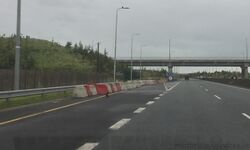
Northern Ireland's Department for Infrastructure never built any motorway service areas, arguing that their road network was too small and the existing facilities in nearby towns would suffice. However, the planning system has approved some private developments, as far as 1994.
In the Republic, new service areas were initially developed by the state, but the private sector has proven to be much faster. Transport Infrastructure Ireland have stated that they are neutral on whether new private service areas should be developed, although they often raise concerns with the potential for traffic issues.
Irish policy is more complicated as it is spread across many different departments. There is a planning policy and a design policy. The concept of providing regular rest breaks along major routes is outlined in the European Union's Trans-European Transport Networks (TEN-T) policy, which calls for parking areas every 60 km on core routes by 2040. Irish policy is also informed by EU laws and guidance on subjects such as driving time regulations, and the move to alternative fuel types.
Spatial Planning and National Road Guidelines for Planning Authorities
This 2012 document about the national road network included a small mention for service areas; the first time it had been written in an operational policy. The document is available from gov.ie. This outlined:
- Online service areas must be developed by the National Roads Authority.
- Offline service areas may be approved when deemed necessary by the local planning authority, but a proliferation of private facilities at national road junctions should be avoided.
- Service areas should not encourage local journeys.
2014 Policy
The National Roads Authority published a detailed 'motorway service area policy', detailing the relationship between privately- and state-owned sites, and the procedure for developing new sites. A copy of it is hosted by Transport Infrastructure Ireland.
- All motorways and major dual carriageways must have a service area at least every 100 km, with rest areas added where the gap is more than 85 km.
- Offline service areas must be within "a few hundred metres" of the motorway.
- The NRA will look at adding online service areas to dual carriageways, but not single carriageway roads.
- Service areas should avoid encouraging local trips.
- Minimum requirements were outlined of: general entrance area, tourist information, convenience store, food store, toilets (including 3 male cubicles, 5 female cubicles, 1 cubicle for disabled users), showers (including mirror and bench), baby changing room, wifi, fuel, electric vehicle charging points, air and water, picnic area, indoor and outdoor children's play areas, refuse points and CCTV coverage.
- Formula for parking capacity provided.
- Traffic calming should be provided if necessary.
- Landscaped bunds should be used to screen the service area from traffic.
- Signage and markings should comply with the Traffic Signs Manual and road design should meet the relevant standards.
- Lay-bys will be withdrawn from public use.
2023 Review
A public consultation on service area facilities was carried out in September 2019, which raised concerns with the planning process, leading to a policy review. The proposed draft policy is available from Transport Infrastructure Ireland.
The proposed new policy confirms the following changes:
- All motorways and major dual carriageways must have a service area at least every 60 km (reduced from 100 km).
- Offline service areas must be within 500 metres of the motorway.
- TII confirmed they had suspended work on tranche 3 service areas, to allow the private sector to get there first. They also confirmed that they won't be developing new sites to compete with existing sites. However, they have suggested that they would push for service areas where needed on a new road scheme.
- Motorway lay-bys will now be for HGVs and garda vehicles only. Garda enforcement areas will be converted to lay-bys, but lay-bys near service areas will be closed.
- TII will develop a website and app providing details on the location and facilities available at service areas.
- From 2017, a new phrase "terminal service area" was introduced, to describe official facilities in ports that mainly cater for HGVs.
Separate to this, a review of service area road signs had been carried out in 2017, but as the subject came up in the consultation, a new signage policy was launched in July 2023. This included provision for signage for rural petrol stations near a motorway, bypassed towns, alternative routes and service areas on single carriageway roads.
A separate policy for major single carriageway roads is expected to be released in future years.